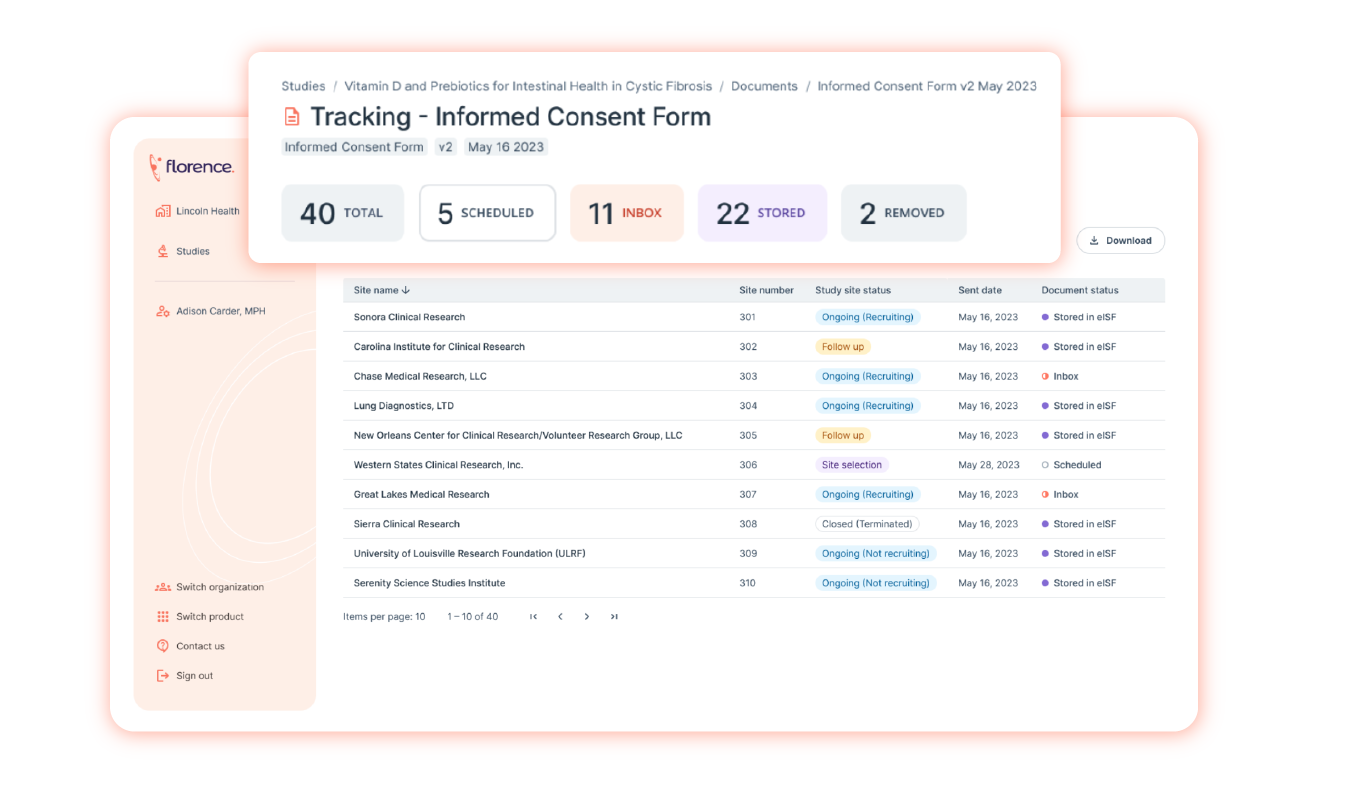Florence Library of FDA Guidance for Electronic Document Management
Florence Library of FDA eSource and eRegulatory Guidance
Over the last fifteen years, the FDA published several guidance documents to help the clinical research industry shift toward electronic document management. Despite the Agency’s efforts, many Good Clinical Practice questions were left unanswered and both sites and sponsors asked for more.
In response, the FDA has compiled and published these GCP email inquiries and responses, collected from 2002 to 2016. The questions stem mainly from three FDA guidance documents:
So where does Florence fit?
As it is our mission at Florence to simplify clinical trial document and project management, we also aim to provide sites and sponsors with an easier way to access, understand, and apply the FDA’s guidance on eSource and eRegulatory.
Currently the FDA’s new published material is challenging to navigate and access. So to save you time and headache, we have created a library of those GCP inquiries regarding electronic processes in clinical investigations.
Inside this library live the original questions, the FDA’s responses, and our summary of those exchanges. Each question and its subsequent summary is linked to a table of contents, so you can simply click a question to access its content.
FDA eRegulatory and eSource Guidance Library Topics
Audits
Are sponsors required to conduct a 21 Part 11 Assessment and/or on site audit when a laboratory is CLIA certified? Should sponsors and other regulated entities perform audits of the vendor’s electronic systems and products? [See more]
Audit Trails
How do we comply with the audit trail requirement when keeping our TMF in an electronic folder, with limited access and back-up by manual creation of documents and scanned documents? Because of a bug in our EDC system, our audit trail was not recorded correctly. Can the automated correction of the audit trail from the vendor along with sufficient validation documentation and evidence of the program operating correctly be approved? [See more]
Case Report Forms
Do the original copies of the signed, dated and completed CRFs as well as documentation of CRF corrections need to be maintained by the study sponsor? Can the sponsor require that only the PI enter the causality and severity data into eCRF? [See more]
What is the FDA accepted definition of certified copies? Can a PDF copy of the original signed version of a Financial Disclosure Form document be given to the sponsor when they are collecting them? [See more]
What are the requirements/guidance on cloud-based servers? Are cloud storage systems secure enough for storing clinical trial data? [See more]
Electronic Data Capture Systems
Which studies are required to use an electronic data capture system? Does an electronic data capture system have to be Part 11 compliant when doing human subject clinical research? [See more]
Does Part 11 apply to electronic health records? We are printing our subjects’ EMRs and certifying them as exact, complete copies, are we required to allow access to our EMR? [See more]
If sponsors and other regulated entities outsource electronic services, who is responsible for meeting the regulatory requirements? Under what circumstances would FDA choose to inspect the electronic service vendor? [See more]
Is it a requirement to have paper backups of regulatory documents, particularly IRB related documents? Does the FDA’s guidance on Electronic Source Data in Clinical Investigations apply to IRBs? [See more]
What access controls should sponsors implement for mobile technology accessed by study participants for use in clinical investigations? When using mobile technology to capture data directly from study participants in clinical investigations, how do sponsors identify the data originator? [See more]
Are printed copies required to be signed and dated by CRA? If we use printed copies of electronic records from another organization, but we cannot verify the copies from them, what is the responsibility of the investigators and sites? [See more]
What is necessary to consider scanned files source documents? What are the requirements that should be met by the system in case the site wants to destroy the primary source after scanning it into an electronic system? [See more]
What is considered an acceptable electronic method for collecting eSignatures? Does FDA certify electronic systems and methods used to obtain electronic signatures? [See more]
Can original source paper documents being used for a current active trial be shipped to off site storage? Can the eCRF be the only source data in a clinical trial and how do you check source data? [See more]
Can sponsors and other regulated entities use and retain electronic copies of source documents in place of the original paper source documents? Can sponsors and other regulated entities used durable electronic storage devices to archive required records from a clinical investigation? [See more]
Does an eTMF system used in conjunction with SOPs need to comply with all aspects of 21 CFR Part 11? Is it acceptable to have sections of the TMF in multiple locations as long as they are retrievable? [See more]
What should sponsors and other regulated entities consider when using a risk-based approach for validation of electronic systems used in clinical investigations? We have installed SAS on our desktops, do we only need to validate these desktops in which data manipulation is done or do we also need to validate the central location where the files are stored? [See more]
Is there a guidance about going electronic with the regulatory binder? For electronic systems owned or managed by sponsors and other regulated entities that fall under the scope of 21 CFR Part 11, what will be FDA’s focus during inspections? [See more]


